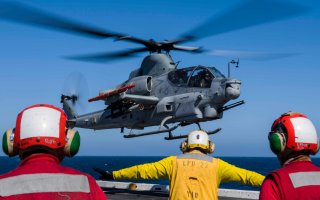America’s AH-1 Attack Helicopter Used To Be a Dogfighter (Really)
In addition to attacking ground and sea targets, it's capable of fighting other helicopters.
Here's What You Need to Know: One Marine recently said the AH-1’s air-to-air role could expand, thanks to the introduction of the F-35B stealth fighter.
The U.S. Marine Corps’s AH-1Z Viper attack helicopter possess a little-known capability. In addition to attacking ground and sea targets, they’re capable of fighting other helicopters -- and, in a pinch, even fixed-wing warplanes.
Tom Demerly, a writer for The Aviationist, was reminded of this fact during an air show at Marine Corps Air Station Pendleton in California in September 2019.
“The AH-1Z Viper gunship on static display had a conspicuous armament package that drew many comments and questions: a pair of what appeared to be inert AIM-9 Sidewinder air-to-air missiles,” Demerly wrote.
The AIM-9 is an infrared-guided dogfighting missile with a maximum range of up to 22 miles in its latest version.
“It’s a possible configuration,” one of the aircrew explained. “We don’t train with them commonly, mostly for loading practice, but it is a capability we have and we wanted to show it.”
The Viper flier might be overstating the rareness of air-to-air missiles on AH-1s. Photos from as recently as 2019 depict AH-1s carrying Sidewinders while flying from U.S. Navy assault ships sailing the Persian Gulf.
And at least one country actually has deployed AH-1s in the air-to-air role during a major war. “The 1980-1988 Iran-Iraq War witnessed numerous helicopter air-combat engagements,” Marine major R. M. Brady wrote in 1992.
“During this war, Iranian AH-1Js engaged Iraqi MI-8 Hip and MI-24 Hind helicopters. Unclassified sources report that the Iranian AH-1 pilots achieved a 10:1 kill ratio over the Iraqi helicopter pilots during these engagements. Additionally, Iranian AH-1 and Iraqi fixed-wing aircraft engagements also occurred.”
Brady noted that until the late 1980s the Marine Corps trained its AH-1 pilots in air-to-air tactics, but halted the practice after deciding that the training strained the helicopters’ airframes. He argued for the tactical training to resume. “There must be a renewed emphasis within the Marine Corps and [the U.S. Navy] on the importance of conducting realistic [air-combat maneuvers] training within the AH-1 community.”
Helicopter ACM training did not resume, although American AH-1s still can carry and fire Sidewinders and also could employ their guns and unguided rockets in the air-to-air role.
But absent specific training, it’s unclear how effective the ‘copters would be as dogfighters. “In order to be an effective [air-to-air warfare] platform, the AH-1 must be flown by aircrew that are knowledgeable and proficient in air combat maneuvers,” Brady wrote.
One Marine recently said the AH-1’s air-to-air role could expand, thanks to the introduction of the F-35B stealth fighter.
Capt. Daniel Kelly, an AH-1Z pilot with Marine Light Attack Helicopter Squadron 169 in Okinawa told AIN that the F-35 helps Marine forces to neutralize radar threats, making helicopters more survivable in the aerial escort role.
The escort role involves AH-1s flying alongside transport helicopters and tiltrotors in order to protect them from enemy forces. Those forces could include fixed-wing warplanes, or even enemy helicopters firing air-to-air missiles.
David Axe served as Defense Editor of the National Interest. He is the author of the graphic novels War Fix, War Is Boring and Machete Squad.
This article first appeared in March 2020.
Image: U.S. Navy photo by Mass Communication Specialist 3rd Class Ryan M. Breeden

